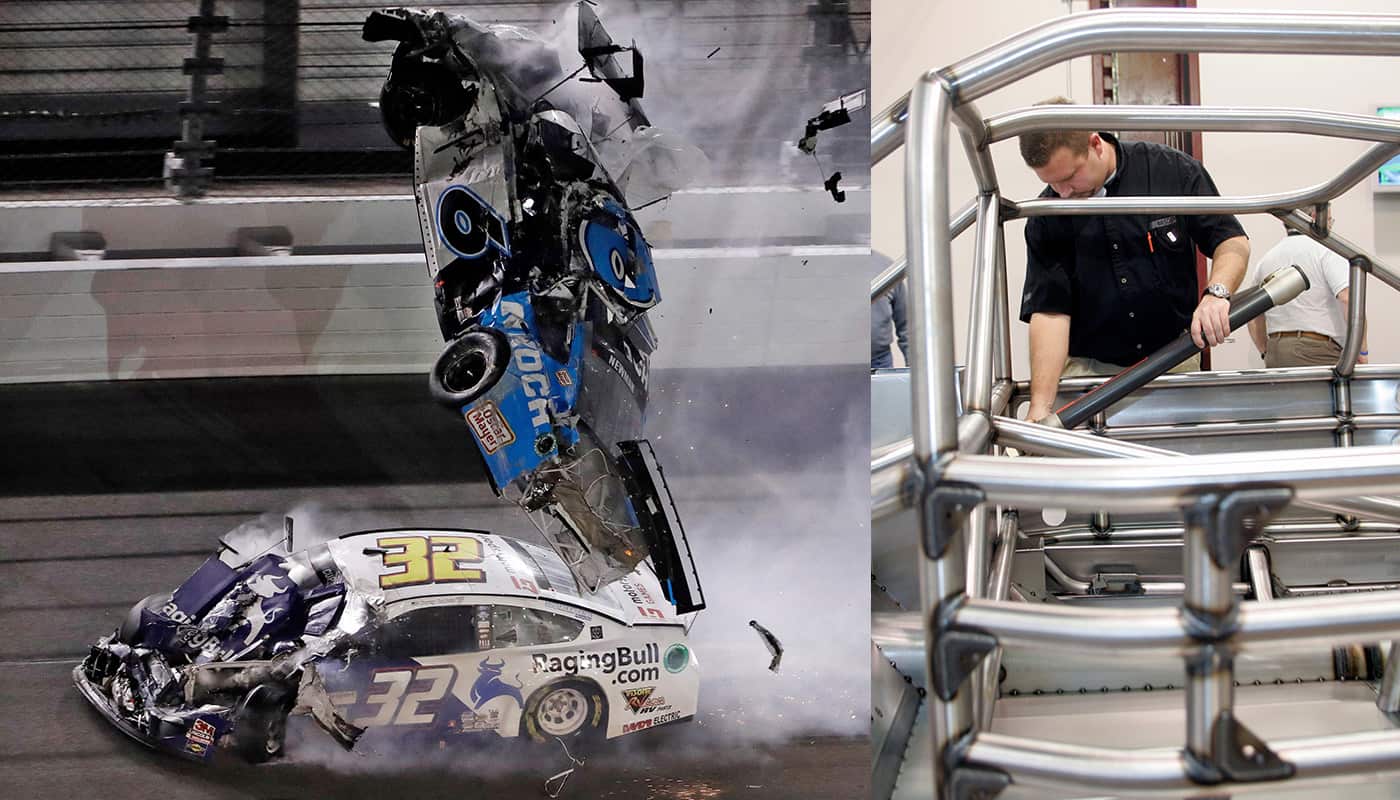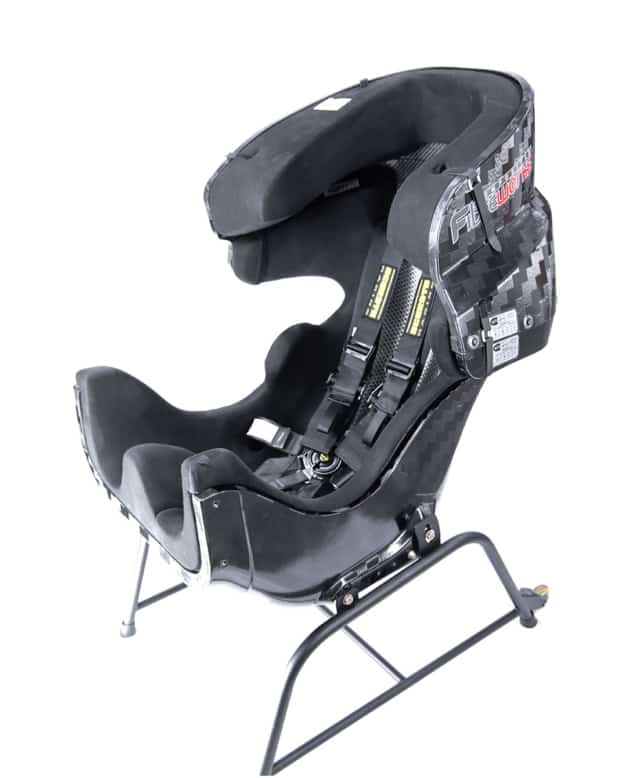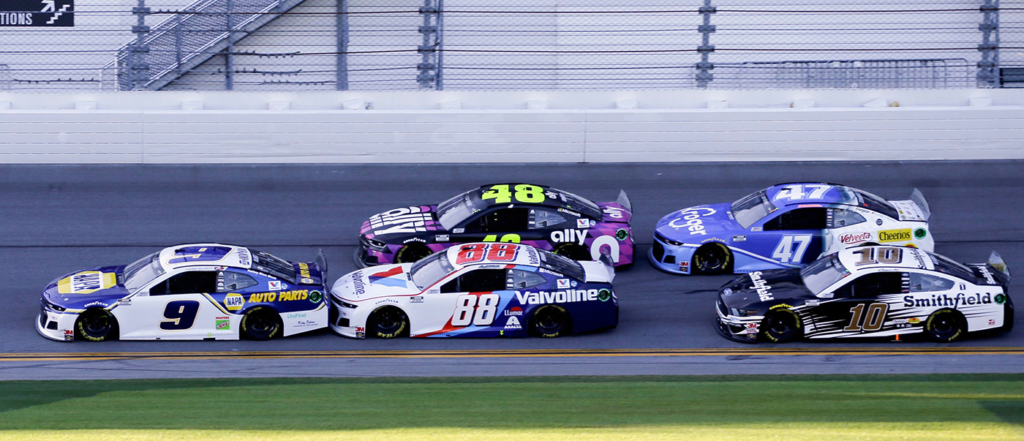Being a racecar driver in NASCAR is a dangerous job. One small mistake can send cars flying, cause multi-car crashes and, in some cases, be fatal. Diandra Leslie-Pelecky explores the science behind some of the features in NASCAR that are designed to keep the drivers safe
Ryan Newman must have been feeling pretty good as he rounded turn four on the last lap of the Daytona 500 on 16 February this year. The 42-year-old NASCAR driver was not only poised to break a 104-race winless streak, he was about to do it at the season’s most prestigious race.
Then everything changed.
Newman’s car was hit from behind and turned. It slammed into the outside track wall so hard that it flipped over, then slid – upside down – back into traffic, where an oncoming car smashed it into the air. After landing, Newman’s battered #6 car slid a couple of hundred metres on its roof before finally coming to a stop.
No NASCAR driver has died or been permanently injured in any of its top three series since 2001. As Newman was helicoptered off by emergency personnel, I couldn’t help but fear that this streak was about to end. But 42 hours later, Ryan Newman walked out of the hospital. It wasn’t until NASCAR cleared him to race again at the end of April that he revealed he remembers almost nothing about the crash. Three months and one day after his accident, Newman finished 15th in the first race since the coronavirus shut down NASCAR in March.
The risk in racing
The National Association for Stock Car Auto Racing – NASCAR – grew out of the illegal liquor trade in the south-east US. Moonshine runners who had souped up their “stock” cars to outrun the law started racing each other. Today, NASCAR’s top level, the NASCAR Cup Series, runs 36 races each season at ovals and a few road courses. The shortest tracks are about 800 m and the longest 4.1 km, with race lengths ranging from 500 to 965 km. The racecars themselves have gone through six generations of development, each featuring major changes and improvements from its predecessor. However, since its founding in 1947, some 32 NASCAR drivers have died during racing, qualifying, practice and testing in the top three series – 28 in the Cup Series alone.
In the past, NASCAR was mostly reactive when it came to safety, and some of the most vocal opposition to safety innovations came from drivers themselves. That changed after four deaths over a 10-month period in 2000–2001. The string of tragedies started with Adam Petty, the fourth generation of a legendary NASCAR family, and ended with Dale Earnhardt’s death at the 2001 Daytona 500. As NASCAR then started developing its fifth-generation racecar following Earnhardt’s death, the newly created NASCAR R&D Center was charged with making safety a top priority.
Nowadays, Newman – a Purdue University-educated engineer – is one of NASCAR’s most vocal safety advocates, especially when it comes to superspeedways like Daytona. The 4 km tri-oval (a cross between a triangle and an oval) has long straightaways and 31° banked turns that make it one of the fastest tracks in NASCAR. In fact, it’s a little too fast. At high speed and high yaw angle (the angle between the front of the car and the direction the car is heading), the laws of aerodynamics make stock cars behave more like aeroplanes than automobiles. Over the years, eight NASCAR Cup drivers have died at Daytona, including Earnhardt – more than at any other track.
After Bobby Allison’s car became airborne and almost went over the catchfence at Daytona’s sister track, Talladega Superspeedway, in 1987, NASCAR mandated “restrictor plates” at both tracks. These limit airflow into the engine, which in turn restricts how much fuel can combust, therefore capping the car’s speed. But even with the engine throttled back to about 410 kW (550 horsepower), the cars routinely reach speeds of 320 km/h (~200 mph).
When packs of cars travel centimetres from each other at speeds above 300 km/h, even one tiny misjudgement can set off a massive chain-reaction crash
Yet, this is still not fast enough for racers. The only way to get more speed out of a car with a restricted engine is to follow another so closely that air flows over both cars as if they were one. The decrease in net drag from this “drafting” lets two cars move 5–8 km/h (3–5 mph) faster than either car could alone. But when packs of cars travel centimetres from each other at speeds high enough to traverse a football field in the blink of an eye, even one tiny misjudgement can set off a massive chain-reaction crash.
Racecar crashes are more dangerous than street-car accidents because racecars have so much more kinetic energy. A typical passenger car going 110 m/s (~70 mph) has 0.5 MJ of kinetic energy. A NASCAR racecar at top speed carries 12 times that – about the energy stored in 1.4 kg of TNT.
When a racecar stops, all this kinetic energy must be converted to other forms of energy. This happens over a timescale of seconds when a car comes in for a pitstop. Kinetic energy changes into heat (e.g. in tyres and brakes), sound (squealing brakes and screeching tyres) and light (glowing brake rotors). In a crash, energy is converted over a much shorter period of time, which leads to higher peak forces. In addition to heat, light and sound, energy may go into deforming the car, or producing rotational motion like spinning or flipping. Managing that energy is the key to keeping drivers safe.
A science experiment on wheels
When NASCAR started, racecars were made by putting roll cages inside ordinary road vehicles. As speeds increased and aerodynamics became more important, it was easier (and safer) to build the car around the roll cage. The fifth-generation racecar marked the first time NASCAR sent a computer-aided design file of the chassis to teams. While each team was allowed to individually develop features such as suspension set-up, NASCAR specified the dimensions, positions and wall thicknesses of every single tube in the chassis to ensure safety standards were kept across all teams. Each of the couple of dozen chassis a team makes over the course of a season is inspected by NASCAR using digital indexing arms and 3D laser scanning. Those that pass are certified with tamperproof radio-frequency identification (RFID) tags that are checked each time the car is presented for competition.
The strongest tubes in the chassis are closest to the driver, allowing the parts of the car furthest away to crush first. The front section is designed to push the engine downward instead of into the driver’s compartment in the event of a collision. The four horizontal doorbars on each side are staggered so that the top bar crushes first, then the next one down and so on, and they’re covered by a metal anti-intrusion plate.
The car’s “greenhouse” (the windscreen, side and rear windows, roof, and the structure supporting it all) poses a more formidable challenge. The driver needs a clear field of vision and an ability to escape the car quickly in the event of fire. That requires a design providing maximum strength with a minimum number of structural components. The windows themselves are made of high-strength laminated polycarbonate. While they can fracture, they are very hard to break, and because there is a layer of polymer film between the two sections, and adhesive mylar tear-offs on the front, any broken pieces can’t go flying too far.

An “Earnhardt Bar” was mandated after a 1996 Talladega crash in which another car’s nose crashed through Earnhardt’s windscreen and broke his sternum. This bar runs vertically down the centre of the windscreen, preventing anything large – like the nose of another car – from getting into the driver’s cockpit. The current Gen-6 car, introduced in 2013, also features a “Newman Bar” that provides extra roof reinforcement. The bar was named after Newman, who was vocal in calling for stronger roofs after going airborne twice in one year at Talladega. It then helped saved his life in the Daytona 2020 crash. The Gen-6 car also enlarged the greenhouse to put more distance between the roof and the driver’s head. The driver’s seat was moved 5 cm away from the door for extra protection against T-bone crashes, in which the nose of one car perpendicularly impacts the driver’s-side door of the other.
NASCAR chassis are built from magnetic steel, rather than materials like titanium aluminides to keep the cost down, but there are plenty of hi-tech materials protecting the driver. The thermoplastic composite Tegris (made by the US materials manufacturer Milliken & Co.) was first used for the newly introduced “splitter” on the fifth-generation car. Jutting out from the bottom of the front bumper and creating higher pressure on top than on the bottom, the device “splits” the air. The increased force on the car’s front end provides more friction – or “grip” – between front tyres and the track. A spoiler accomplishes the same task in the rear.
Tegris starts out as a cold-drawn, polypropylene oxide (PPO) tape yarn that is then woven into sheets. Unlike carbon-fibre composites, Tegris doesn’t require resin. The drawing process produces a highly oriented PPO core surrounded by an amorphous coating. Because the amorphous material melts at a lower temperature than crystalline PPO, the amorphous sections fuse together when the fabric is heated under pressure. Although Tegris has about 70% the strength of carbon fibre, it is more impact-resistant, lighter and about a tenth of the price. A sheet of Tegris on the driver’s-side door over the chassis frame prevents anything from getting through the doorbars and into the cockpit.
Before the exterior sheet metal goes on, blocks of energy-absorbing IMPAXX – a highly engineered, extruded thermoplastic foam – are fitted over the doors. In contrast to squishy foams that extend the time of collision and decrease the peak force, IMPAXX is rigid. Rather than temporarily storing energy, the stiff foam deforms, absorbing energy equal to the applied force multiplied by the foam’s displacement. The energy used to crush the foam is energy that never reaches the driver.
The final layer of protection
Everything inside the car is also optimized to manage kinetic energy. In fact, today’s aluminium or carbon-fibre driver-containment seats look more like something you’d find on a rocket than in a car. Custom-poured resilient-foam inserts conform to the driver’s body and padded arms wrap around the driver’s shoulders, pelvis and head to minimize side-to-side and backward motion.
One thing seats can’t protect against, however, is forward motion. NASCAR requires a six-point driver restraint harness, with wider belts than on a street car to distribute force better. One polyester belt runs over each shoulder, another two hold the pelvis, while two further belts go around the legs to prevent “submarining” – the driver slipping under the belt in an impact. Racing restraint belts are sturdier than passenger-car belts because they must tolerate higher forces, but they still stretch a little in an impact to lengthen the time over which the driver comes to a stop.

In the 1990s restraint belts had been improved so that they held drivers’ bodies tightly to their seats during a crash, but there wasn’t anything holding their heads. A typical human head weighs around 4.5 kg. Combine that with a 1.3 kg helmet, and in a 40g collision (deceleration at 392 m/s2), that head can snap forward at an acceleration of 107g (almost 1050 m/s2) – more than enough to break the driver’s neck. Basilar skull fractures – caused by a driver’s head whipping forward – became one of the most common causes of on-track deaths, including that of Earnhardt.
Since 2001 NASCAR has mandated the use of head-and-neck restraints. These devices consist of a harness worn around the chest or on the shoulders, with tethers that connect to the helmet. When the car stops suddenly, the tethers stop the head from snapping forward and instead slow it down gradually.
Solving one problem, however, often uncovers others. In the last few years, Dale Earnhardt Jr – the late Earndardt’s son who retired from NASCAR racing in 2017 – has raised awareness of crash-induced concussions, which has caused many drivers to re-examine their helmet choice. In fact, the 2020 Daytona 500 was only the second race in which Ryan Newman was using a new type of helmet. His head gear came from Arai, a company specializing in the more demanding needs of motorcycle racers, who have only their helmet between them and the track.
Helmets must serve a range of purposes: they need to be fireproof, cushioned to minimize forces on the head, and hard enough to prevent anything from piercing or crushing them. They also need to be as light as possible. Arai uses a proprietary combination of fibres and resin to create a fibreglass that is 30% stronger than traditional fibreglass but weighing just 0.5–0.6 kg rather than the 1.3–1.5 kg of a typical motorsports helmet.
Newman’s helmet also incorporated a layer of Zylon (a thermoset liquid-crystalline polyoxazole) around the crown area. Zylon, which has a tensile strength 1.6 times that of Kevlar, is just starting to appear in NASCAR, although Formula 1 has used Zylon tethers since 2001 to prevent wheels that come off cars in crashes from becoming projectiles. Indeed, Formula 1 also requires Zylon reinforcement in all helmets after a 700 g spring came off another car and hit driver Felipe Massa’s helmet in 2009, penetrating the headgear and fracturing his skull.
Newman and his team made his car as safe as possible. But there’s one more element that played a big role in helping him survive the accident.
SAFER tracks
Originally, concrete racetrack walls and the wire catchfences that followed were designed to keep cars out of the grandstands rather than to protect drivers. But by 1998, a staggering 41 drivers had died at Indianapolis Motor Speedway (which is not just used for NASCAR) through collisions with walls and other cars – some of the latter caused by track walls redirecting the car back into the traffic. Tony George, then-president of IndyCar (another US racing series) and owner of the speedway, set out to make the track safer.
The probability of two cars crashing into the same spot within moments of each other on a motorway is low, so barriers that cushion an impact by breaking or permanently deforming are sufficient. But they won’t work on a racetrack, where a dozen cars may be involved in a single accident. In addition, a racetrack barrier must be quickly repairable (and quickly cleaned up) so the race can continue.
The first instinct was to make the walls softer. Many tracks still use bundled-up old tyres, which works well for lower-energy impacts, but not the high-speed collisions at Indianapolis. In 1998 IndyCar tested 40 cm-diameter, high-density polyethylene (HDPE) tubes that were placed in front of the speedway’s existing concrete walls and covered by inch-thick overlapping HDPE plates. Known as the Polyethylene Energy Dissipation System (PEDS), it allowed the car’s kinetic energy to move the plates and deform the cylinders. Unfortunately, although the PEDS successfully decreased the accelerations the drivers experienced when hitting the wall, it scattered debris all over the track. The HDPE also tended to “grab” a car when it hit, stopping it instead of slowing it down.

IndyCar engaged Dean Sicking (an engineer and inventor who was then at the University of Nebraska) to redesign the PEDS, but he realized the problem wasn’t the concept, it was the material. So instead of using plastic, Sicking proposed steel. After overcoming plenty of scepticism that a harder material would provide better protection – and with funding from Indycar – he started work on the Steel And Foam Energy Reducing (SAFER) barrier. When NASCAR joined the project a few years later, he had to modify the design because the two types of cars carried different amounts of kinetic energy. Any barrier had to work for both.
The track-facing part of a SAFER barrier has five hollow-steel tubes, each with a 20 cm2 cross section and 0.5-cm-thick wall, stacked one atop another and stitch-welded together. High-strength nylon straps connect the impact surface to the track’s existing concrete wall. The space between the two walls is filled with 50-cm-thick wedges of foam, with the wedges’ narrow ends closest to the track.
When a car hits the SAFER barrier, its kinetic energy is used to move the massive steel wall and crush the foam wedges. The wedge shape helps the wall respond to the different kinetic energy scales of different cars. Indy officials routinely saw 100g and greater peak accelerations when cars hit concrete walls. The SAFER barrier brought most hits down to the 60–65g range. Today, SAFER barriers are mandatory on all IndyCar and NASCAR tracks (except Eldora Speedway, a small dirt track). The walls aren’t exactly soft, but they do save lives.
I would never deny that there was an element of luck involved in Ryan Newman being able to walk away from a spectacular crash with minimal injury. But most of the credit goes to the scientists and engineers – and the drivers – who refuse to accept that death is an inevitable part of racing.




